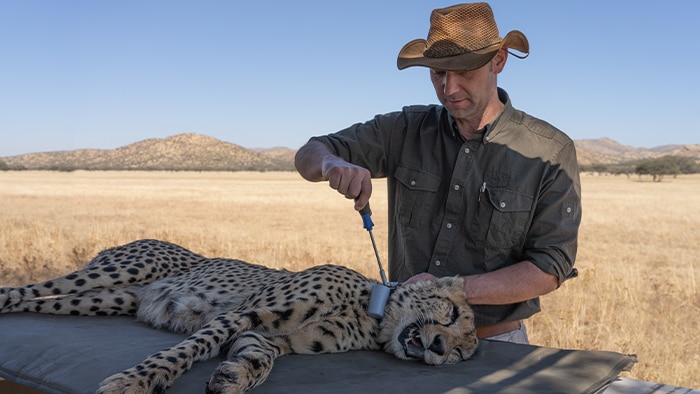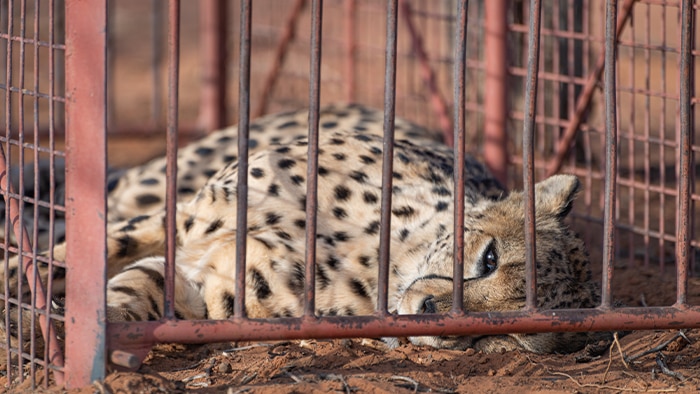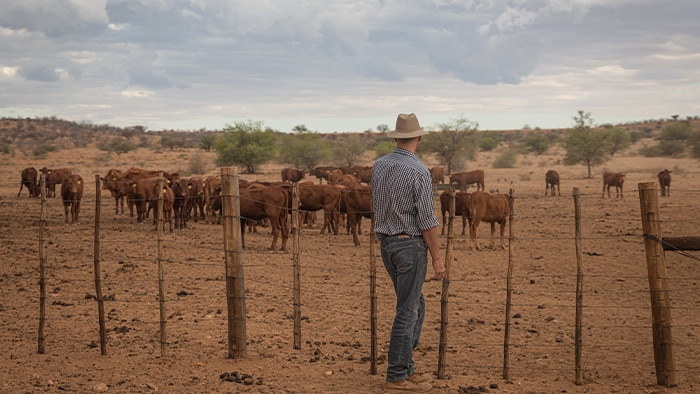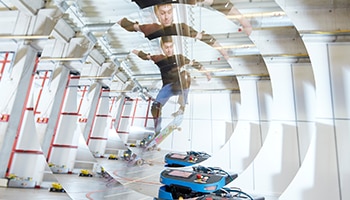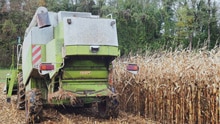When cheetahs snatch calves from cattle herds, farmers tend to reach for their guns. A group of biologists have found a solution to this conflict between man and beast – and sensors from SICK have something to do with it.
Into the wild: species conservation with sensors from SICK
When humans and animals compete for food and space, there is bound to be conflict – and it rarely ends up going well for the animal. The case of cheetahs in Namibia is no different. The country is home to around 1,300 of these endangered big cats. The problem for them is that they share the land with the cattle herds of the farmers who live there, and calves aged up to six months are easy prey for the relatively weak cheetahs. So, it is no wonder that farmers have, in the past, tended to reach for their guns to protect their cattle. Fortunately, a peaceful resolution to this conflict has been found thanks to a team of biologists from the Leibniz Institute for Zoo and Wildlife Research in Berlin, who have been conducting in-depth research into cheetahs in Namibia since 2005 to investigate this specific situation.
Nearest Socket 150 Kilometers away
However, before they can find out more about these extremely shy big cats, they have to trap them. Once the cheetahs have been anesthetized, the researchers weigh and measure them, draw blood samples and give them collars fitted with GPS trackers so that they can trace their movements.
When I joined the project in 2005, I spent five or six hours of every day sitting in the car so I could check all eight of our cage traps,” says Dr. Jörg Melzheimer, the coordinator of the cheetah project. On the dirt tracks of Africa, that was anything but comfortable and took up a lot of precious research time. “We really needed a solution to the problem, and it had to be one that would run off solar power and a 12-volt power supply, because when you’re out in the bush, the nearest power socket is 150 km away,” says Melzheimer. So, the techsavvy biologist spent several years tinkering away on a series of solutions, but none of them was entirely satisfactory. He ended up ordering some ordinary photoelectric sensors from China. These were intended to trigger the traps and a computer was meant to send a notification to his phone.
But there was a problem. “The relays for the photoelectric sensors would make a clicking noise, which meant that the wary cheetahs would immediately pull back out of the trap,” says Melzheimer. “So, we had even fewer chances to catch the animals.” The researcher racked his brains for quite some time before getting in touch with SICK in spring 2022. “For a sensor manufacturer like SICK, my problem was probably one of the easiest assignments it had ever taken on,” he recalls with amusement. “I got the feeling that all the man on the phone needed to do was open a drawer and pull out the right sensor.
Maximum Power in miniature format
Normally used in industrial automation, the W4F sensor is now realizing its full potential in the Namibian bush. It packs exceptional performance into a miniature format and is not sensitive to optical interference. “That by itself makes life a lot easier, because the old sensors had a habit of triggering the doors of the traps when the sun shone on them at just the wrong angle,” explains Melzheimer. “When that happened, we couldn’t catch any cheetahs at all, because the trap was shut.” Another benefit is that the incredible precision of the W4F means that the traps are triggered at exactly the right moment. That reliably prevents other species, such as warthogs, from being trapped by mistake, and also minimizes other false trips. Both used to be frequent occurrences.
Popular meeting point for cheetahs
Our story could perfectly well end on this happy note, but let us go back to the problem of resolving the conflict with farmers. As a result of their extensive research over many years – more than 250 cheetahs in Namibia have been fitted with GPS trackers over the course of the project – Melzheimer and his team happened upon an unexpected and valuable finding that was to prove the key to resolving the conflict between humans and animals. “By recording the movements of the cheetahs, we found that they had what you might call communication hubs,” explains Melzheimer. “These are special places where the meet up – rather like a trendy bar for people.” Because cheetahs are solitary creatures spread relatively thinly across the areas where they live, nature has had to come up with a way for the species to survive. “The animals come to these communication hubs to find suitable mates,” says Melzheimer.
Something similar happens with other species as well, such as the red deer, but only during the rutting season. The cheetahs frequent their meeting places all year round – behavior that Melzheimer says has not been observed in any other species to date. The indepth research carried out into this extraordinary use of space over a period from 2010 to 2020 was something of an exception. According to Melzheimer, such discoveries are usually not possible owing to the brief durations of research projects or the limited numbers of animals involved. It was worth it, too. The findings were not only a spectacular gain for wildlife research but also a boon for the cheetahs. “The communication hubs are distributed very evenly across the landscape, roughly 25 kilometers apart, and barely change if the cheetahs aren’t disturbed.
If the farmers know where these meeting places are, they can distribute their herds across the grazing land in such a way that the cows and their calves are far enough away for the calves to stay out of danger,” says Melzheimer. The team managed to persuade the farmers that this was a better alternative to killing the cheetahs. “Shooting the animals is actually counterproductive, because they would then move their meeting places and it would no longer be possible to plan around them,” says Melzheimer. The plan worked.
Today, farmers are given maps with the communication hubs marked on them, and they can position their herds on the land accordingly. Given that the average size of a farm in Namibia is roughly 5,000 hectares, that is usually not a problem. The good news for the farmers is that they lose around 80% fewer calves than they did before they were able to apply this knowledge.
Patented live trap
It would be difficult for any story to have a happier ending, but we want to return to the subject of the SICK sensors once more. Although they were not directly involved in the actual process of finding a resolution to the conflict between cheetahs and farmers, their use did mark a turning point in wildlife research by making it significantly more efficient, effective and low-impact.
“As far as I’m concerned, the practice of trapping wildlife for research was previously stuck in the 18th century, and the sensors from SICK have catapulted it into the 21st,” says Melzheimer. “Our ‘smart trap’ was actually patented in early 2023 and is now being used in other research projects as well.” The story of the cheetahs and the farmers makes for persuasive proof of just how important this research is for both humans and the natural world. It is wonderful to think that with its sensors, SICK has made its own small contribution to this research, to wildlife conservation and perhaps even to helping humans and animals to co-exist peacefully.
Momentum: Magazine from the 2022 Annual Report
It is worthwhile to scrutinize success stories for momentum. What was the moment or occasion that set everything rolling and brought success?
The articles in this magazine show that momentum is no coincidence and is more than just a chain of fortunate circumstances. Momentum comes from intuition, inspiration, experience, competence and passion.

